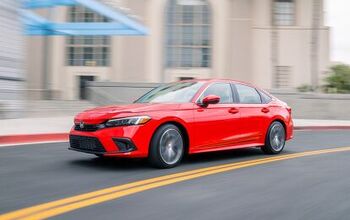Defiant Kangaroos Stand Firmly in Path of Soulless, Self-Driving Future

Who knew strange animals born with a sack stuck to their bellies would prove to be the largest hurdle in the advent of driverless vehicles? In areas where you’ll find marsupials, anyway.
While North American drivers have long grown used to smacking deer with their personal vehicles, it’s a different story in the land of Paul Hogan, Nicole Kidman, and the amiable fellow from Jurassic Park. A full 80 percent of vehicle-animal collisions on that extremely large island and/or continent involve a kangaroo. It now seems the manner in which the limber creatures get around has created a headache for a certain Scandinavian car company — one hoping to lead the industry in hands-off driving.
Volvo has already flung XC90s outfitted with autonomous driving technology to the four corners of the earth: its native Sweden, the U.S., and, starting in late 2015, Australia. The automaker has capitalized on the Australian Driverless Vehicle Initiative for the testing of its self-driving fleet, plying long, lonely outback roads with the aim of finessing its technology into something marketable.
While Volvo expected its available Large Animal Detection system to keep driverless vehicle occupants safe, Australia ain’t Sweden. And kangaroo certainly do not behave like moose or elk. According to the Australian Broadcasting Corporation, the manner in which the bouncy animals travel — in the air, mostly — completely confuses the collision avoidance system.
Large animals have a knack for causing bone-shattering, roof-crumpling crashes, so Volvo’s 90-Series vehicles employ a forward facing camera that matches animal shapes to a database of creatures. After measuring the distance between the vehicle using radar, the system automatically applies the brakes as needed. Unfortunately, kangaroos, besides being nature’s pogo stick, are the closest thing we have to a real shapeshifter. Also, they’re rarely ever seen standing motionless.
“We’ve noticed with the kangaroo being in mid-flight … when it’s in the air it actually looks like it’s further away, then it lands and it looks closer,” said David Pickett, Volvo Australia’s technical manager.
Volvo’s system use the ground as a reference point. When a kangaroo leaps into the air while crossing a road, the confused car might assume there’s no need to take evasive action.
“We identify what a human looks like by how a human walks, because it’s not only the one type of human — you’ve got short people, tall people, people wearing coats. The same applies to a roo. If you look at a roo sitting at the side of a road, standing at the side of a road, in motion, all these shapes are actually different.”
The kangaroo detection problem needs a solution before any automaker can sell an autonomous vehicle in that country. Still, Volvo isn’t swayed. Pickett believes the company can overcome the issue and that the eventual proliferation of driverless vehicles will go ahead as planned.
[Image: bluedeviation/ Flickr ( CC BY-ND 2.0)]

More by Steph Willems
Latest Car Reviews
Read moreLatest Product Reviews
Read moreRecent Comments
- AZFelix UCHOTD (Used Corporate Headquarters of the Day):Loaded 1977 model with all the options including tinted glass windows, People [s]Mugger[/s] Mover stop, and a rotating restaurant. A/C blows cold and it has an aftermarket Muzak stereo system. Current company ran okay when it was parked here. Minor dents and scrapes but no known major structural or accident damage. Used for street track racing in the 80s and 90s. Needs some cosmetic work and atrium plants need weeding & watering – I have the tools and fertilizer but haven’t gotten around to doing the work myself. Rare one of a kind design. No trades or low ball offers – I know what I got.
- El scotto UH, more parking and a building that was designed for CAT 5 cable at the new place?
- Ajla Maybe drag radials? 🤔
- FreedMike Apparently this car, which doesn't comply to U.S. regs, is in Nogales, Mexico. What could possibly go wrong with this transaction?
- El scotto Under NAFTA II or the USMCA basically the US and Canada do all the designing, planning, and high tech work and high skilled work. Mexico does all the medium-skilled work.Your favorite vehicle that has an Assembled in Mexico label may actually cross the border several times. High tech stuff is installed in the US, medium tech stuff gets done in Mexico, then the vehicle goes back across the border for more high tech stuff the back to Mexico for some nuts n bolts stuff.All of the vehicle manufacturers pass parts and vehicles between factories and countries. It's thought out, it's planned, it's coordinated and they all do it.Northern Mexico consists of a few big towns controlled by a few families. Those families already have deals with Texan and American companies that can truck their products back and forth over the border. The Chinese are the last to show up at the party. They're getting the worst land, the worst factories, and the worst employees. All the good stuff and people have been taken care of in the above paragraph.Lastly, the Chinese will have to make their parts in Mexico or the US or Canada. If not, they have to pay tariffs. High tariffs. It's all for one and one for all under the USMCA.Now evil El Scotto is thinking of the fusion of Chinese and Mexican cuisine and some darn good beer.

































Comments
Join the conversation
When you say "amiable fellow from Jurassic Park." do you mean Sam Neill? Because he's actually a kiwi born in Northern Ireland. We'll take him as our own though, as we have Russell Crowe, hah.
I immediately thought of Courtney Barnett's lyrics of marsupial roadkill. "Taxidermied kangaroos are littered on the shoulders A possum Jackson Pollock is painted in the tar"